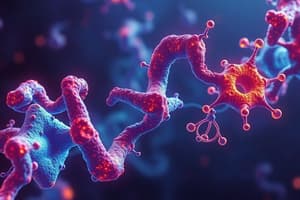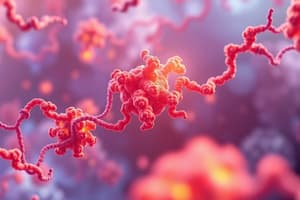Podcast
Questions and Answers
What type of proteins can bind to phosphotyrosine docking sites?
What type of proteins can bind to phosphotyrosine docking sites?
- Proteins with PH domains
- Proteins with SH3 domains
- Proteins with PDZ domains
- Proteins with SH2 domains (correct)
What occurs to activated receptor tyrosine kinases?
What occurs to activated receptor tyrosine kinases?
- They are recycled within the membrane.
- They phosphorylate phospholipases.
- They are turned off before being digested.
- They are brought into the cell and digested by lysosomes. (correct)
What initiates the translocation of glucose transporters to the plasma membrane in muscle and fat cells?
What initiates the translocation of glucose transporters to the plasma membrane in muscle and fat cells?
- Insulin-induced IRS-1/PI-3 kinase/PKB signalling (correct)
- Increased blood glucose levels
- Direct binding of glucose to transporters
- Activation of AMPK pathways
What role does Grb play in signal transduction?
What role does Grb play in signal transduction?
Which insulin receptor isoform is primarily associated with adult tissue metabolism?
Which insulin receptor isoform is primarily associated with adult tissue metabolism?
What happens to glucose during insulin signaling?
What happens to glucose during insulin signaling?
What does ligand binding to RTKs typically cause?
What does ligand binding to RTKs typically cause?
What can mutations in genes related to insulin signaling lead to?
What can mutations in genes related to insulin signaling lead to?
What specific function do insulin receptors have?
What specific function do insulin receptors have?
Which of the following is true about insulin signaling pathways?
Which of the following is true about insulin signaling pathways?
What is the main role of tyrosine kinase in receptor tyrosine kinases?
What is the main role of tyrosine kinase in receptor tyrosine kinases?
How do G Protein Coupled Receptors (GPCRs) primarily differ in structure from receptor tyrosine kinases (RTKs)?
How do G Protein Coupled Receptors (GPCRs) primarily differ in structure from receptor tyrosine kinases (RTKs)?
What occurs when a ligand binds to the monomers of receptor tyrosine kinases?
What occurs when a ligand binds to the monomers of receptor tyrosine kinases?
Which energy molecule is primarily involved in the function of receptor tyrosine kinases?
Which energy molecule is primarily involved in the function of receptor tyrosine kinases?
What is a significant pathway triggered by receptor tyrosine kinases?
What is a significant pathway triggered by receptor tyrosine kinases?
What is the primary time scale during which receptor tyrosine kinases operate compared to G Protein Coupled Receptors?
What is the primary time scale during which receptor tyrosine kinases operate compared to G Protein Coupled Receptors?
Which of the following is NOT a characteristic of receptor tyrosine kinases?
Which of the following is NOT a characteristic of receptor tyrosine kinases?
What happens to the kinase active site after the activation lip is forced out?
What happens to the kinase active site after the activation lip is forced out?
Which type of receptors lack intrinsic kinase activity and instead activate cytosolic tyrosine kinases?
Which type of receptors lack intrinsic kinase activity and instead activate cytosolic tyrosine kinases?
What is a consequence of protein phosphorylation by receptor tyrosine kinases?
What is a consequence of protein phosphorylation by receptor tyrosine kinases?
Flashcards
G Protein Coupled Receptors (GPCRs)
G Protein Coupled Receptors (GPCRs)
A type of cell surface receptor that has a single polypeptide chain with seven transmembrane domains, involved in various cellular processes like signal transduction and hormone binding.
Receptor Tyrosine Kinases (RTKs)
Receptor Tyrosine Kinases (RTKs)
A type of enzyme-linked cell surface receptor that dimerizes upon ligand binding, activating its intrinsic tyrosine kinase activity.
Tyrosine Kinase
Tyrosine Kinase
A type of protein that catalyzes the transfer of a phosphate group from ATP to a tyrosine residue on a target protein.
Signal Transduction
Signal Transduction
Signup and view all the flashcards
Dimerization
Dimerization
Signup and view all the flashcards
Tyrosine Phosphorylation
Tyrosine Phosphorylation
Signup and view all the flashcards
Kinase Domain
Kinase Domain
Signup and view all the flashcards
Activation of RTKs
Activation of RTKs
Signup and view all the flashcards
Activation Lip
Activation Lip
Signup and view all the flashcards
Signal Cascade
Signal Cascade
Signup and view all the flashcards
SH2 Domain
SH2 Domain
Signup and view all the flashcards
Adaptor Protein
Adaptor Protein
Signup and view all the flashcards
Signaling Protein
Signaling Protein
Signup and view all the flashcards
Endocrine Signaling
Endocrine Signaling
Signup and view all the flashcards
Glucose Uptake
Glucose Uptake
Signup and view all the flashcards
Insulin Receptor
Insulin Receptor
Signup and view all the flashcards
Insulin-Induced IRS-1/PI3K/PKB Signaling Pathway
Insulin-Induced IRS-1/PI3K/PKB Signaling Pathway
Signup and view all the flashcards
MAPK (Mitogen-Activated Protein Kinase) Pathway
MAPK (Mitogen-Activated Protein Kinase) Pathway
Signup and view all the flashcards
Study Notes
Kinase-Linked Receptors
- Kinase-linked receptors are a type of enzyme-linked cell surface receptor.
- They have two monomers.
- They have 7 transmembrane domains.
- Ligand binding triggers multiple cell responses.
- The energy molecule involved is ATP.
- Linked enzymes are enzyme kinases.
- Time scale is measured in hours.
Learning Outcomes
- Describe the structure of receptor tyrosine kinases.
- Explain the activation and signal transduction of receptor tyrosine kinases.
- Explain the insulin/insulin receptor signaling pathway and its role in metabolism.
GPCRs vs RTKs
- Definition: GPCRs are G protein-coupled receptors while RTKs are receptor tyrosine kinases.
- Structure: GPCRs have 7 transmembrane domains, RTKs have 2 monomers.
- Ligand Binding: GPCRs trigger only one cell response from a single ligand, RTKs trigger multiple cell responses from a single ligand.
- Energy Molecule: GPCRs use GTP, RTKs use ATP.
- Linked Enzymes: GPCRs do not have linked enzymes, RTKs use enzyme kinases.
- Time Scale: GPCRs response time is measured in seconds, RTKs response time is measured in hours.
Enzyme-Linked Receptors
- Discovered through growth factor investigation.
- Include nerve growth factor, platelet-derived growth factor, fibroblast growth factor, and epidermal growth factor.
- Once activated, the enzyme acts like an enzyme or forms a complex with another enzyme.
- Can trigger multiple signal transduction pathways simultaneously.
- Involved in diseases like diabetes and cancer.
Structure of Receptor Tyrosine Kinases
- Consist of extracellular domains that bind ligands.
- Feature transmembrane domains.
- Intracellular domains with tyrosine kinase sites.
- Tyrosine kinase adds phosphate groups from ATP to tyrosine residues on target proteins.
Receptor Tyrosine Kinase Mechanism of Action (MOA)
- Many receptor tyrosine kinase variants have the same structure but different mechanisms of action.
- Phosphorylation leads to increased gene transcription.
- Main types include receptor tyrosine kinases, serine/threonine kinases, and cytokine receptors.
- Some cytokine receptors have no intrinsic kinase activity; they activate cytosolic tyrosine kinase.
Receptor Tyrosine Kinase Activation
- Ligand binding to RTK monomers results in dimer formation.
- The dimer's conformation changes, activating the kinase.
- One receptor phosphorylates a tyrosine residue within the "activation lip" of the other receptor.
Signal Transmission
- The activation lip moves out of the kinase active site, allowing ATP binding & kinase activity enhancement.
- Phosphorylation at conserved tyrosine residues creates "docking sites" for intracellular signaling proteins (e.g. SH2 domains).
Signal Transduction
- Signalling proteins (activated upon ligand binding) transmit signals into the cell's interior.
- Adaptor proteins facilitate signaling cascades.
- A message for cell proliferation occurs; gene mutations can make this pathway consistently "on" and cause cancer.
- Activated receptor tyrosine kinases are deactivated by being brought into the cell and digested by lysosomes.
Insulin Signaling (Simple Version)
- Insulin is produced and stored until needed.
- Released via other cell signaling pathways (endocrine signaling).
- Insulin binds to its receptor.
- Signal transduction results in glucose transporters relocating to the plasma membrane.
- Glucose uptake increases.
Insulin Signaling (Detailed)
- An overview of the insulin receptor signaling pathway demonstrates intricate pathways involving numerous proteins.
- Components such as glucose, SNARE complex, various kinases (PI3K, Akt, etc.), and transcription factors are key players.
- Pathways related to glucose transport, glycogen synthesis, and protein synthesis are highlighted.
Members of the Type II Receptor Tyrosine Kinase Family
- Includes insulin-like growth factor-1 receptor (IGF-1R).
- Components such as insulin receptor isoform A (InsR-A), insulin receptor isoform B (InsR-B), and other variants are part of this family.
Multiple Ligands and Receptors
- Multiple ligands can bind to different receptors, and some have preferential binding.
- An example provided is the IGF-II mitogen, related to cancer, and insR-A link to diabetes.
- Ligand binding activates receptors.
Regulation of Glucose Uptake
- Glucose transporters are stored in cytoplasmic vesicles.
- Insulin induces IRS-1/PI-3-kinase/PKB signaling.
- Vesicle translocation to the plasma membrane occurs.
- Vesicle fusion with the membrane allows glucose uptake into the cell.
Mitogen Effects
- Grb activates Ras, Raf, and the MAPK pathway.
- Phosphorylation activates transcription factors, which regulate gene expression.
- Some genes with insulin responsive elements are affected.
Summary of Receptor Tyrosine Kinases
- Generally, RTKs dimerize after ligand binding.
- This activates intrinsic cytoplasmic tyrosine kinases, leading to autophosphorylation of the cytoplasmic receptor domain.
- Adaptor proteins bind to the activated/phosphorylated receptor domain, activating other adaptor/signaling proteins.
- The signal propagates through the signaling cascade.
Insulin Example Summary
- Insulin binds to the already dimerized tetrameric insulin receptor.
- Ligand binding triggers autophosphorylation in the receptor's cytoplasmic domain.
- Insulin recruits IRS-1 for PI3-kinase/PKB signaling.
- The process causes glycogen uptake and synthesis.
Studying That Suits You
Use AI to generate personalized quizzes and flashcards to suit your learning preferences.




